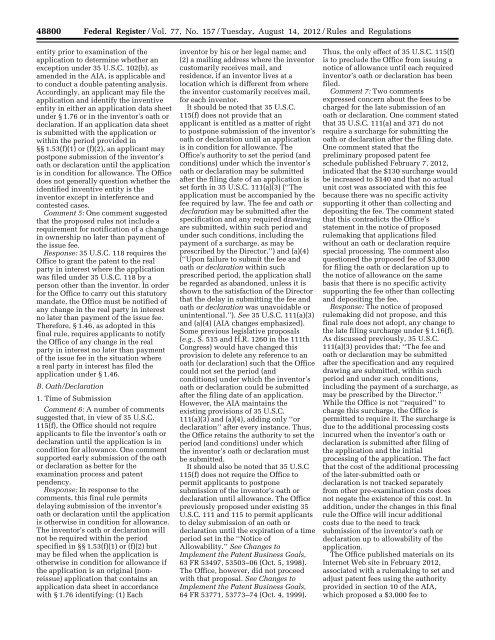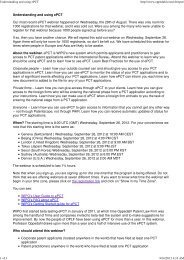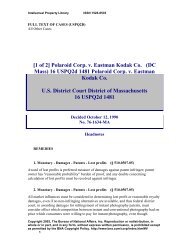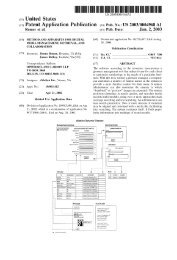48800 Federal Register / Vol. 77, No. 157 / Tuesday, August 14, 2012 / Rules and Regulationssro<strong>be</strong>rts on DSK5SPTVN1PROD with RULESentity prior to examination of theapplication to determine whether anexception under 35 U.S.C. 102(b), asamended in the AIA, is applicable andto conduct a double patenting analysis.Accordingly, an applicant may file theapplication and identify the inventiveentity in either an application data sheetunder § 1.76 or in the inventor’s oath ordeclaration. If an application data sheetis submitted with the application orwithin the period provided in§§ 1.53(f)(1) or (f)(2), an applicant maypostpone submission of the inventor’soath or declaration until the applicationis in condition for allowance. The Officedoes not generally question whether theidentified inventive entity is theinventor except in interference andcontested cases.Comment 5: One comment suggestedthat the proposed rules not include arequirement for notification of a changein ownership no later than payment ofthe issue fee.Response: 35 U.S.C. 118 requires theOffice to grant the patent to the realparty in interest where the applicationwas filed under 35 U.S.C. 118 by aperson other than the inventor. In orderfor the Office to carry out this statutorymandate, the Office must <strong>be</strong> notified ofany change in the real party in interestno later than payment of the issue fee.Therefore, § 1.46, as adopted in thisfinal rule, requires applicants to notifythe Office of any change in the realparty in interest no later than paymentof the issue fee in the situation wherea real party in interest has filed theapplication under § 1.46.B. Oath/Declaration1. Time of SubmissionComment 6: A num<strong>be</strong>r of commentssuggested that, in view of 35 U.S.C.115(f), the Office should not requireapplicants to file the inventor’s oath ordeclaration until the application is incondition for allowance. One commentsupported early submission of the oathor declaration as <strong>be</strong>tter for theexamination process and patentpendency.Response: In response to thecomments, this final rule permitsdelaying submission of the inventor’soath or declaration until the applicationis otherwise in condition for allowance.The inventor’s oath or declaration willnot <strong>be</strong> required within the periodspecified in §§ 1.53(f)(1) or (f)(2) butmay <strong>be</strong> filed when the application isotherwise in condition for allowance ifthe application is an original (nonreissue)application that contains anapplication data sheet in accordancewith § 1.76 identifying: (1) Eachinventor by his or her legal name; and(2) a mailing address where the inventorcustomarily receives mail, andresidence, if an inventor lives at alocation which is different from wherethe inventor customarily receives mail,for each inventor.It should <strong>be</strong> noted that 35 U.S.C.115(f) does not provide that anapplicant is entitled as a matter of rightto postpone submission of the inventor’soath or declaration until an applicationis in condition for allowance. TheOffice’s authority to set the period (andconditions) under which the inventor’soath or declaration may <strong>be</strong> submittedafter the filing date of an application isset forth in 35 U.S.C. 111(a)(3) (‘‘Theapplication must <strong>be</strong> accompanied by thefee required by law. The fee and oath ordeclaration may <strong>be</strong> submitted after thespecification and any required drawingare submitted, within such period andunder such conditions, including thepayment of a surcharge, as may <strong>be</strong>prescri<strong>be</strong>d by the Director.’’) and (a)(4)(‘‘Upon failure to submit the fee andoath or declaration within suchprescri<strong>be</strong>d period, the application shall<strong>be</strong> regarded as abandoned, unless it isshown to the satisfaction of the Directorthat the delay in submitting the fee andoath or declaration was unavoidable orunintentional.’’). See 35 U.S.C. 111(a)(3)and (a)(4) (AIA changes emphasized).Some previous legislative proposals(e.g., S. 515 and H.R. 1260 in the 111thCongress) would have changed thisprovision to delete any reference to anoath (or declaration) such that the Officecould not set the period (andconditions) under which the inventor’soath or declaration could <strong>be</strong> submittedafter the filing date of an application.However, the AIA maintains theexisting provisions of 35 U.S.C.111(a)(3) and (a)(4), adding only ‘‘ordeclaration’’ after every instance. Thus,the Office retains the authority to set theperiod (and conditions) under whichthe inventor’s oath or declaration must<strong>be</strong> submitted.It should also <strong>be</strong> noted that 35 U.S.C115(f) does not require the Office topermit applicants to postponesubmission of the inventor’s oath ordeclaration until allowance. The Officepreviously proposed under existing 35U.S.C. 111 and 115 to permit applicantsto delay submission of an oath ordeclaration until the expiration of a timeperiod set in the ‘‘Notice ofAllowability.’’ See Changes toImplement the Patent Business Goals,63 FR 53497, 53503–06 (Oct. 5, 1998).The Office, however, did not proceedwith that proposal. See Changes toImplement the Patent Business Goals,64 FR 53771, 53773–74 (Oct. 4, 1999).VerDate Mar2010 17:28 Aug 13, 2012 Jkt 226001 PO 00000 Frm 00026 Fmt 4701 Sfmt 4700 E:\FR\FM\14AUR6.SGM 14AUR6Thus, the only effect of 35 U.S.C. 115(f)is to preclude the Office from issuing anotice of allowance until each requiredinventor’s oath or declaration has <strong>be</strong>enfiled.Comment 7: Two commentsexpressed concern about the fees to <strong>be</strong>charged for the late submission of anoath or declaration. One comment statedthat 35 U.S.C. 111(a) and 371 do notrequire a surcharge for submitting theoath or declaration after the filing date.One comment stated that thepreliminary proposed patent feeschedule published February 7, 2012,indicated that the $130 surcharge would<strong>be</strong> increased to $140 and that no actualunit cost was associated with this fee<strong>be</strong>cause there was no specific activitysupporting it other than collecting anddepositing the fee. The comment statedthat this contradicts the Office’sstatement in the notice of proposedrulemaking that applications filedwithout an oath or declaration requirespecial processing. The comment alsoquestioned the proposed fee of $3,000for filing the oath or declaration up tothe notice of allowance on the samebasis that there is no specific activitysupporting the fee other than collectingand depositing the fee.Response: The notice of proposedrulemaking did not propose, and thisfinal rule does not adopt, any change tothe late filing surcharge under § 1.16(f).As discussed previously, 35 U.S.C.111(a)(3) provides that: ‘‘The fee andoath or declaration may <strong>be</strong> submittedafter the specification and any requireddrawing are submitted, within suchperiod and under such conditions,including the payment of a surcharge, asmay <strong>be</strong> prescri<strong>be</strong>d by the Director.’’While the Office is not ‘‘required’’ tocharge this surcharge, the Office ispermitted to require it. The surcharge isdue to the additional processing costsincurred when the inventor’s oath ordeclaration is submitted after filing ofthe application and the initialprocessing of the application. The factthat the cost of the additional processingof the later-submitted oath ordeclaration is not tracked separatelyfrom other pre-examination costs doesnot negate the existence of this cost. Inaddition, under the changes in this finalrule the Office will incur additionalcosts due to the need to tracksubmission of the inventor’s oath ordeclaration up to allowability of theapplication.The Office published materials on itsInternet Web site in February 2012,associated with a rulemaking to set andadjust patent fees using the authorityprovided in section 10 of the AIA,which proposed a $3,000 fee to
Federal Register / Vol. 77, No. 157 / Tuesday, August 14, 2012 / Rules and Regulations48801sro<strong>be</strong>rts on DSK5SPTVN1PROD with RULESpostpone submission of the inventor’soath or declaration until the applicationis in condition for allowance. The finalrule to set and adjust patent fees undersection 10 of the AIA will not includethis proposal.Comment 8: One comment suggestedthat examiners should <strong>be</strong> properlycompensated for any additional workrequired by delays in establishing theproper inventorship.Response: The Office will require thatthe inventorship <strong>be</strong> named in anapplication data sheet (or the inventor’soath or declaration) prior toexamination. Thus, the inventorshipwill <strong>be</strong> established <strong>be</strong>fore an applicationis examined and examiners should notexperience any delays with respect tothe establishment of the properinventorship. Additionally,compensation of examiners is not asubject of this rulemaking.2. AvermentsComment 9: A num<strong>be</strong>r of commentssuggested that the Office should notrequire the inventor’s oath ordeclaration to contain any statementsother than the statements required by 35U.S.C. 115(b).Response: 35 U.S.C. 115(c) providesthat the Office may specify additionalinformation relating to the inventor andto the invention that is required to <strong>be</strong>included in an oath or declaration under35 U.S.C. 115(a). In response tocomments, however, the Office isrequiring that an oath or declarationcontain only the averments required by35 U.S.C. 115(b), if the inventorinformation is provided in anapplication data sheet. The Office hasnot retained regulatory averments to <strong>be</strong>made in the inventor’s oath ordeclaration, such as acknowledgementof the duty of disclosure under § 1.56.However, a person may not execute anoath or declaration unless that personhas reviewed and understands thecontents of the application, includingthe claims, and is aware of the duty todisclose to the Office all informationthat is material to patentability. See§ 1.63(c).Comment 10: One comment statedthat the averment in proposed§ 1.63(a)(5) that the application ‘‘wasmade or authorized to <strong>be</strong> made by theinventor’’ should not <strong>be</strong> required in anoath or declaration that is signed by theassignee.Response: 35 U.S.C. 115(b)(1) requiresthat an oath or declaration contain astatement that the application was madeor was authorized to <strong>be</strong> made by theaffiant or declarant irrespective ofwhether the application was filed by theassignee. Therefore, § 1.63(a)(4) requiresthe oath or declaration to state that theapplication was made or was authorizedto <strong>be</strong> made by the person executing theoath or declaration.3. Inventors NamedComment 11: A num<strong>be</strong>r of commentssuggested that the Office should notrequire the inventor’s oath ordeclaration to provide the names of allof the inventors, which could <strong>be</strong>provided together in another document(such as an application data sheet).Response: An inventor executing anoath or declaration need only identifyhimself or herself as an inventor,provided an application data sheet issubmitted to identify the completeinventive entity.Comment 12: One comment statedthat proposed § 1.63(d)(2) should <strong>be</strong>deleted since the naming of theinventive entity should <strong>be</strong> establishedby filing an application data sheet in acontinuing application and thus therewould <strong>be</strong> no need to request removal ofinventors.Response: A request to remove one ormore inventors is retained for thosesituations where an application datasheet is not supplied concurrently withor <strong>be</strong>fore submission of the inventor’soath or declaration.4. Copies in Continuing ApplicationsComment 13: One comment suggestedthat the Office scan the inventorstatement or assignment into theOffice’s image file wrapper (IFW)system so that a copy of any previouslyfiled statement would not <strong>be</strong> required ina later-filed application claiming<strong>be</strong>nefit.Response: Consistent with preexistingpractice and the notice ofproposed rulemaking, the Office isrequiring a copy of the oath ordeclaration or an assignment serving asthe oath or declaration in continuingapplications so that the Office candetermine whether an oath ordeclaration has <strong>be</strong>en executed by orwith respect to each inventor in acontinuing application.Comment 14: One commentquestioned whether a combinationassignment and oath or declaration in aparent application would need to <strong>be</strong>recorded against a continuation or adivisional application when also usedin the continuation or divisionalapplication. The comment alsoquestioned whether the assignee listedon such an assignment would still needto <strong>be</strong> the owner when submitting theoath or declaration in the continuationor divisional application.Response: Section 1.63(d)(1) providesthat a newly executed oath orVerDate Mar2010 17:28 Aug 13, 2012 Jkt 226001 PO 00000 Frm 00027 Fmt 4701 Sfmt 4700 E:\FR\FM\14AUR6.SGM 14AUR6declaration under § 1.63 is not requiredfor a continuing application where acopy of the oath or declaration from theearlier-filed application is provided.Where the oath or declaration is setforth in an assignment document thatwas recorded against the parentapplication, there is no requirement thatthe copy <strong>be</strong> again recorded against thecontinuing application. 35 U.S.C.115(g)(1) provides that the requirementunder 35 U.S.C. 115 for an oath ordeclaration shall not apply to anindividual named as the inventor or ajoint inventor in an application thatclaims <strong>be</strong>nefit under 35 U.S.C. 120, 121,or 365(c) of an earlier-filed application,if: (1) An oath or declaration meetingthe requirements of 35 U.S.C. 115(a) wasexecuted by the individual and wasfiled in connection with the earlier-filedapplication; (2) a substitute statementmeeting the requirements of 35 U.S.C.115(d) was filed in connection with theearlier-filed application with respect tothe individual; or (3) an assignmentmeeting the requirements of 35 U.S.C.115(e) was executed with respect to theearlier-filed application by theindividual and was recorded inconnection with the earlier-filedapplication.Comment 15: One comment assertedan inconsistency <strong>be</strong>tween proposed§ 1.63(d)(1)(iii) which requires a newoath or declaration from those inventors<strong>be</strong>ing added and § 1.63(d)(2), whichpermits deletion by a separate paperwithout a new oath or declaration. Thecomment indicated that it is not clearhow the statements in the oath ordeclaration filed in the parentapplication can remain true where acopy of the declaration from the parentis filed along with declarations executedby only the newly added inventors.Other comments noted that proposed§§ 1.63(a)(4) and (a)(6) would preventthe use of a copy of an oath ordeclaration in continuation-in-partapplications and possibly continuationand divisional applications.Response: Section 1.63(d), as adoptedin this final rule, provides for use of acopy of the inventor’s oath ordeclaration from a prior-filedapplication in a continuing application,including a continuation-in-partapplication. 35 U.S.C. 115(g) does notrequire a new inventor’s oath ordeclaration if: (1) An oath or declarationmeeting the requirements of 35 U.S.C.115(a) was executed by the individualand was filed in connection with theearlier-filed application; (2) a substitutestatement meeting the requirements of35 U.S.C. 115(d) was filed in connectionwith the earlier-filed application withrespect to the individual; or (3) an
- Page 1:
UNIFORM CERTIFICATE OF ATTENDANCE F
- Page 4 and 5:
SPTO explains the America Invents A
- Page 6 and 7:
PTO/SB/01A (01-09)Approved for use
- Page 8 and 9:
PTO/SB/ (06-12)Approved for use thr
- Page 10 and 11:
PTO/ (06-12)Approved for use throug
- Page 12 and 13:
PTO/(06-1Approved for use through 0
- Page 14 and 15:
What will change about the oath ord
- Page 16 and 17:
Action item●●●If you have not
- Page 18 and 19:
But 37 CFR § 1.63 says:A person ma
- Page 20 and 21:
●●●Combined assignment anddec
- Page 22 and 23:
●●●●●●Consequences of i
- Page 24 and 25:
How to file the ADSs●●If you pr
- Page 26 and 27: Supplemental ADSAny ADS filed after
- Page 28 and 29: Provisionals●●●Rules are a bi
- Page 30 and 31: Are all assignees applicants?●●
- Page 32 and 33: Substitute Statement●●●This f
- Page 34 and 35: ●●●Docket consequences of the
- Page 36 and 37: New Rule-46 practice67●●●Rule
- Page 38 and 39: Consequences of AIA for PCT filers
- Page 40 and 41: If you are entrusted the US nationa
- Page 42 and 43: ●●●Choosing between a “bypa
- Page 44 and 45: ●●●Getting your name and addr
- Page 46 and 47: Exercises relating to September 16,
- Page 48 and 49: Important AIA webinar September 6
- Page 50 and 51: Exercises relating to September 16,
- Page 52 and 53: 48776 Federal Register / Vol. 77, N
- Page 54 and 55: sroberts on DSK5SPTVN1PROD with RUL
- Page 56 and 57: sroberts on DSK5SPTVN1PROD with RUL
- Page 58 and 59: sroberts on DSK5SPTVN1PROD with RUL
- Page 60 and 61: sroberts on DSK5SPTVN1PROD with RUL
- Page 62 and 63: sroberts on DSK5SPTVN1PROD with RUL
- Page 64 and 65: sroberts on DSK5SPTVN1PROD with RUL
- Page 66 and 67: sroberts on DSK5SPTVN1PROD with RUL
- Page 68 and 69: sroberts on DSK5SPTVN1PROD with RUL
- Page 70 and 71: sroberts on DSK5SPTVN1PROD with RUL
- Page 72 and 73: sroberts on DSK5SPTVN1PROD with RUL
- Page 74 and 75: 48798 Federal Register / Vol. 77, N
- Page 78 and 79: 48802 Federal Register / Vol. 77, N
- Page 80 and 81: 48804 Federal Register / Vol. 77, N
- Page 82 and 83: 48806 Federal Register / Vol. 77, N
- Page 84 and 85: 48808 Federal Register / Vol. 77, N
- Page 86 and 87: 48810 Federal Register / Vol. 77, N
- Page 88 and 89: 48812 Federal Register / Vol. 77, N
- Page 90 and 91: 48814 Federal Register / Vol. 77, N
- Page 92 and 93: 48816 Federal Register / Vol. 77, N
- Page 94 and 95: sroberts on DSK5SPTVN1PROD with RUL
- Page 96 and 97: sroberts on DSK5SPTVN1PROD with RUL
- Page 98 and 99: 48822 Federal Register / Vol. 77, N
- Page 100 and 101: sroberts on DSK5SPTVN1PROD with RUL
- Page 102: 48826 Federal Register / Vol. 77, N





